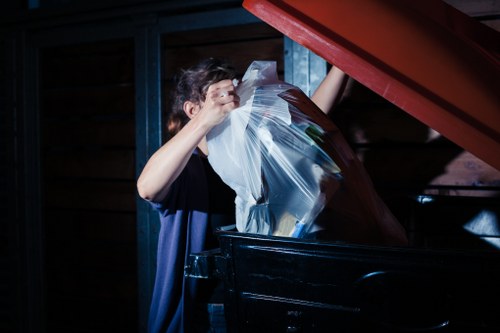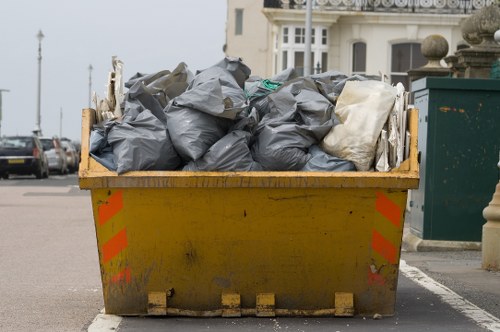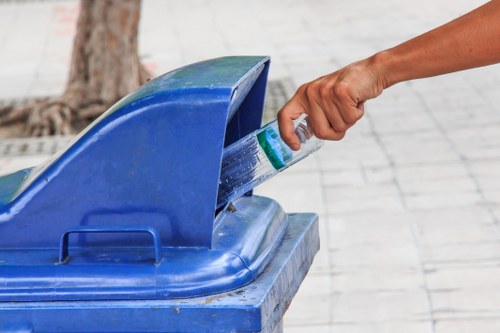Construction Waste Clearance in Osterley: Efficient and Eco-Friendly Solutions
Introduction to Construction Waste Clearance

In the bustling area of Osterley, construction projects are a common sight. Whether it's residential builds, commercial developments, or renovation projects, managing construction waste is a critical aspect of any project. Effective waste clearance not only ensures compliance with local regulations but also promotes environmental sustainability.
Construction waste includes materials like concrete, wood, metals, bricks, and more. Without proper clearance, this waste can lead to cluttered sites, increased costs, and potential environmental hazards. Therefore, understanding the importance and methods of construction waste clearance in Osterley is essential for builders, contractors, and property owners alike.
In this article, we will delve into the best practices for construction waste clearance in Osterley, explore the benefits of professional waste management services, and provide actionable tips to ensure your project remains clean, efficient, and eco-friendly.
Why Proper Waste Clearance Matters

Proper construction waste clearance is vital for several reasons. Firstly, it maintains the aesthetic and safety standards of the construction site. Accumulated waste can create hazards for workers and visitors, increasing the risk of accidents.
Secondly, effective waste management contributes to environmental preservation. By responsibly disposing of or recycling construction materials, we reduce the strain on landfills and minimize the ecological footprint of construction activities.
Moreover, adhering to waste clearance regulations in Osterley helps avoid legal penalties and fines. Local authorities have strict guidelines on how construction waste should be handled, and non-compliance can result in hefty fines and project delays.
Types of Construction Waste

Understanding the different types of construction waste is the first step in effective clearance. Common categories include:
- Concrete and Masonry: Includes broken bricks, blocks, and concrete remnants.
- Wood and Timber: Offcuts, pallets, and untreated wood waste.
- Metals: Includes steel, copper, aluminum, and other scrap metals.
- Plastics: Packaging materials, pipes, and other plastic components.
- Drywall and Insulation: Residual materials from interior finishing.
- Hazardous Waste: Paints, solvents, and other materials that require special handling.
Each type of waste requires specific handling and disposal methods to ensure safety and compliance with environmental standards.
Environmental Impact of Construction Waste

Construction waste has a significant impact on the environment. Improper disposal can lead to soil contamination, water pollution, and harm to wildlife. For example, hazardous materials like paints and solvents can leach into the ground, affecting local ecosystems and potentially entering the water supply.
Recycling and reusing materials can mitigate these effects. Metals can be melted down and reused, wood can be repurposed for other construction projects, and concrete can be crushed and recycled for use in new structures. By adopting sustainable waste clearance practices, construction projects can significantly reduce their environmental footprint.
In Osterley, there is a growing emphasis on green building practices. Proper waste management aligns with these initiatives, promoting a healthier environment and supporting the community's sustainability goals.
Regulations and Compliance in Osterley

Compliance with local regulations is mandatory for construction waste clearance in Osterley. These regulations are designed to ensure that waste is managed responsibly, reducing environmental impact and maintaining public safety.
The key regulatory aspects include:
- Waste Segregation: Different types of waste must be sorted and handled separately. This facilitates recycling and proper disposal.
- Permits and Licensing: Certain types of waste disposal may require specific permits. Contractors must obtain the necessary licenses before transporting or disposing of regulated materials.
- Reporting and Documentation: Accurate records of waste generation, transportation, and disposal must be maintained. This ensures transparency and accountability.
- Environmental Impact Assessments: Large projects may require assessments to evaluate the potential environmental effects of waste clearance operations.
Non-compliance can lead to legal consequences, including fines and operational shutdowns. Therefore, staying informed and adhering to local regulations is crucial for successful construction waste management.
Benefits of Professional Waste Clearance Services
Efficiency and Expertise
Hiring professional waste clearance services in Osterley ensures that waste is managed efficiently and in compliance with all regulations. These experts have the necessary knowledge and equipment to handle various types of construction waste, minimizing delays and complications.
Cost-Effectiveness
While outsourcing waste management may seem like an additional expense, it often proves cost-effective in the long run. Professionals can optimize the waste clearance process, reducing the volume of waste through recycling and efficient disposal methods.
Environmental Responsibility
Professional services prioritize environmentally friendly practices, such as recycling and proper disposal of hazardous materials. This ensures that your construction project aligns with sustainability goals and contributes positively to the community.
Steps for Effective Construction Waste Clearance

1. Planning and Assessment
Begin by assessing the scope of the construction project and estimating the potential waste generated. This helps in selecting the appropriate waste management strategies and services.
2. Waste Segregation
Sort waste into categories such as recyclables, non-recyclables, and hazardous materials. Proper segregation simplifies the disposal process and enhances recycling efforts.
3. Choosing the Right Disposal Methods
Select disposal methods that align with the type of waste and local regulations. Options include recycling, landfilling, or specialized disposal for hazardous materials.
4. Hiring Professional Services
Engage reputable waste clearance companies in Osterley to handle the logistics of waste transportation and disposal. Ensure they have the necessary licenses and follow best practices.
5. Monitoring and Documentation
Keep detailed records of waste generation, transportation, and disposal. Regular monitoring ensures compliance and helps in identifying areas for improvement.
Recycling and Reuse Opportunities

Recycling and reusing construction materials not only reduce waste but also lower project costs. Materials like metal, wood, and concrete can often be repurposed for future projects or sold to recycling facilities.
In Osterley, several recycling centers accept construction waste, providing an eco-friendly alternative to traditional disposal methods. By partnering with these facilities, construction projects can enhance their sustainability and support the local economy.
Additionally, innovative reuse strategies, such as using reclaimed wood for new structures or repurposing concrete for landscaping, contribute to a circular economy where materials are continuously reused, minimizing waste.
Hazardous Waste Management

Handling hazardous construction waste requires special attention and procedures. Materials like asbestos, lead-based paints, and certain solvents pose significant health and environmental risks if not managed properly.
Key steps in managing hazardous waste include:
- Identification: Recognize and categorize hazardous materials present on the construction site.
- Proper Storage: Store hazardous waste in secure containers to prevent leaks and accidental exposure.
- Licensed Disposal: Use licensed disposal services that specialize in handling and transporting hazardous materials.
- Compliance: Adhere to all local regulations and guidelines regarding the management of hazardous waste.
Failing to manage hazardous waste correctly can lead to severe legal consequences and long-term environmental damage. It is imperative to prioritize safety and compliance when dealing with such materials.
Innovative Technologies in Waste Clearance

The construction industry is increasingly adopting innovative technologies to enhance waste clearance efficiency. Technologies such as waste tracking software, automated sorting systems, and sustainable processing techniques are revolutionizing how construction waste is managed.
For instance, waste tracking software allows project managers to monitor waste generation in real-time, enabling timely interventions and adjustments to waste management strategies. Automated sorting systems improve the accuracy and speed of waste segregation, reducing the reliance on manual processes.
Moreover, sustainable processing techniques like waste-to-energy conversion and advanced recycling methods are providing new avenues for minimizing the environmental impact of construction waste. Integrating these technologies into waste clearance operations in Osterley can lead to more sustainable and cost-effective outcomes.
Cost Considerations in Waste Clearance

Managing construction waste effectively involves careful consideration of various costs. Key factors influencing the cost of waste clearance include the volume and type of waste, transportation distances, and the disposal methods employed.
Recycling certain materials can offset costs by generating revenue through the sale of scrap metals or reclaimed wood. Additionally, opting for local waste clearance services in Osterley can reduce transportation expenses and support the local economy.
It is essential to balance cost with sustainability and compliance. Investing in professional waste clearance services may incur higher upfront costs but can lead to long-term savings through efficient waste management, avoidance of fines, and enhanced project reputation.
Choosing the Right Waste Clearance Partner
Selecting a reliable waste clearance partner is crucial for the success of your construction project in Osterley. Consider the following factors when making your choice:
- Experience and Expertise: Choose companies with a proven track record in construction waste management and a deep understanding of local regulations.
- Comprehensive Services: Opt for providers that offer a full range of services, including waste collection, segregation, recycling, and disposal.
- Environmental Commitment: Ensure the company prioritizes sustainable practices and has certifications or memberships with environmental organizations.
- Transparent Pricing: Look for clear and competitive pricing structures without hidden fees.
- Customer Support: Reliable customer service and prompt support are essential for addressing any issues that may arise during the project.
By thoroughly evaluating potential partners based on these criteria, you can ensure seamless and effective waste clearance for your construction project.
Benefits of Sustainable Waste Clearance Practices

Adopting sustainable waste clearance practices offers numerous benefits for construction projects in Osterley:
- Environmental Protection: Reduces the negative impact on the environment by minimizing landfill use and promoting recycling.
- Cost Savings: Recycling and reusing materials can lower disposal costs and even generate additional revenue.
- Regulatory Compliance: Ensures adherence to environmental laws and avoids legal penalties.
- Enhanced Reputation: Demonstrates a commitment to sustainability, which can attract environmentally conscious clients and partners.
- Resource Efficiency: Maximizes the use of available materials, reducing the need for new resource extraction.
Implementing these practices not only benefits the environment but also contributes to the overall success and sustainability of construction projects.
Case Studies: Successful Waste Clearance in Osterley

Residential Development Project
A recent residential development in Osterley successfully implemented a comprehensive waste clearance plan. By partnering with a professional waste management company, they managed to recycle over 60% of the construction waste, significantly reducing landfill contributions and project costs.
Commercial Building Renovation
A commercial building renovation project utilized advanced waste tracking software to monitor waste generation in real-time. This enabled the project managers to adjust waste management strategies promptly, ensuring efficient clearance and compliance with local regulations.
Eco-Friendly Office Complex
An eco-friendly office complex in Osterley incorporated sustainable waste clearance practices, including waste-to-energy conversion and the use of recycled materials in construction. This approach not only minimized environmental impact but also enhanced the building's green credentials.
These case studies highlight the effectiveness of professional and sustainable waste clearance methods in achieving successful construction outcomes in Osterley.
Future Trends in Construction Waste Management

The construction industry is continually evolving, and so are the practices surrounding waste management. Future trends in construction waste clearance are expected to focus on greater automation, advanced recycling technologies, and increased use of digital tools for waste tracking and management.
One emerging trend is the integration of artificial intelligence (AI) and machine learning to optimize waste sorting and recycling processes. AI can enhance the accuracy and efficiency of waste segregation, leading to higher recycling rates and reduced manual labor.
Additionally, the development of biodegradable construction materials and innovative recycling techniques will further minimize the environmental impact of construction waste. As sustainability becomes increasingly prioritized, construction waste management will play a critical role in the industry's transition towards greener practices.
Tips for Managing Construction Waste Effectively

- Create a Waste Management Plan: Outline the procedures for waste generation, segregation, and disposal before the project begins.
- Educate Your Team: Train workers on proper waste handling and the importance of adhering to waste management protocols.
- Use Recyclable Materials: Whenever possible, opt for materials that can be easily recycled or repurposed.
- Monitor Waste Generation: Regularly track the amount and types of waste produced to identify areas for improvement.
- Partner with Reputable Waste Services: Collaborate with experienced waste clearance companies that prioritize sustainability and compliance.
Implementing these tips can lead to more efficient waste management, cost savings, and a positive environmental impact for your construction projects in Osterley.
Conclusion

Construction waste clearance is a crucial component of any construction project in Osterley. By adopting effective waste management strategies, adhering to local regulations, and partnering with professional waste clearance services, you can ensure your project remains efficient, cost-effective, and environmentally responsible.
Embracing sustainable practices not only benefits the environment but also enhances your project's reputation and supports the community's sustainability goals. As the construction industry continues to evolve, staying informed about the latest waste management trends and technologies will position your projects for success.
Don’t let construction waste hold your project back. Contact us today to learn how our expert waste clearance services can support your construction needs in Osterley.